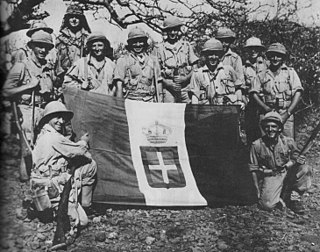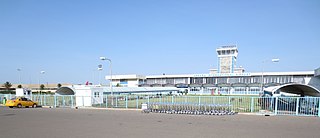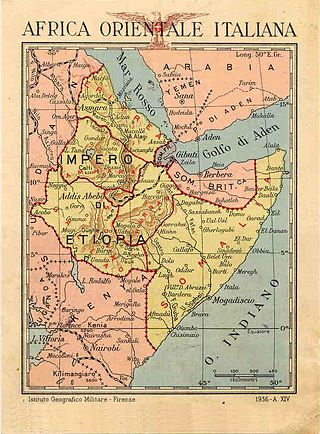Features
The total development was almost 5000 km, of which 400 already built in Italian Eritrea in the preparation phase for the Second Italo-Ethiopian War. [4] [3]
The main roads, all paved and served by important infrastructural works, were at the same time joined by a capillary secondary connection network (up to 4000 km of development) which guaranteed the connection of the smaller towns to the primary road system. [5]
The construction of the AOI road system was urgently implemented on orders from Mussolini himself, but there were significant increases in the cost of the works. From Italy in five years were sent nearly 63530 workers to create the roads; and were also used 56600 Ethiopians and Eritreans, plus 46000 workers from Yemen and Sudan. [6]
Sadly, there also were huge health & security problems: in order to build the Massaua-Decamerè, in 7 months died 247 Italians and 501 Eritrean workers (nearly 4 workers dead every day!) [7] . Indeed -because the roads were done also during the second italian ethiopian war- there were attaks on the workers: the Gondrand massacre occurred on February 13, 1936, near the northern Ethiopian town of Mai Lahlà, the current Rama (a camp of civilian workers for the logistics company Gondrand, engaged at the time in road construction, was attacked at dawn by Ethiopian soldiers who killed nearly 70 of them).
As far as passenger transport was concerned, were created eight major communication lines -served with modern buses- which also included overnight stays for passengers in newly-built hotels. [8] The lines were:
- 1. Massawa-Asmara-Gondar (with overnight stay in Asmara and Adi Arcai);
- 2. Massawa-Dessiè-Addis Ababa (overnight in Quiha and Dessie);
- 3. Assab-Dessiè-Addis Ababa (overnight in Dessie);
- 4. Addis Ababa-Gimma;
- 5. Addis Ababa-Ambò (on the Lechemti route);
- 6. Mogadishu-Kismayo (overnight in Modum);
- 7. Mogadishu-Dolo (overnight in Baidoa);
- 8. Mogadishu-Bulo Burti-Rocca Littorio (overnight in El Mos)
The great arterial road (Asmara-Addis Abeba) was built in record time from 1935 to 1938 employing tens of thousands of Italian and indigenous Ethiopian & Yemeni workers. At the end of 1938 a weekly bus service of the national transport company "Fratelli Gondrand" was activated on this route, which took 5 days. Initially the journey was made only during the day due to possible attacks by Ethiopian guerrillas in the Abyssinian north. But already in April 1940, the repression carried out against the indigenous guerrillas in the area made it possible to reduce the journey time to 18 hours between Addis Ababa and Asmara Vito Zita [9]
At the beginning of 1940, all the fundamental roads of the "AOI Road Plan" had been built, except for some sections on the Addis Ababa-Gondar road (also included in the subsequent multi-year plan) and on the Gondar-Dessiè road.
As for the second road project of 1937, only the Addis Ababa-Harar was completed. Work was also underway on two of the three transoceanic roads that were to connect Mogadishu to the center of the Empire. The Italian Eritrea roads were nearly all completed in 1939 [10]
Furthermore, at the beginning of the World War II work was carried out between Gimma and Sirè, between Lechemti and Ghimbi, and finally between Gimma and Scioa Ghimira. And according to the 1939 projects, paralleled to the road Assab-Dessie was going to be created a railway that from Assab on the Red sea was going to reach Addis Abeba and later Mogadishu on the Indian ocean. [11]
The Imperial road, that was going to connect the three capitals of the Italian empire in east Africa -Asmara, Addis Abeba and Mogadishu-, was done only between Addis Abeba and Asmara (with continuation until the port of Massawa). Additionally there was a huge section—built just before the beginning of World War II—near the border between Somalia and Ethiopia (Neghelli - Dolo).

Italian East Africa was an Italian colony in the Horn of Africa. It was formed in 1936 after the Second Italo-Ethiopian War through the merger of Italian Somalia, Italian Eritrea, and the newly occupied Ethiopian Empire.

The East African campaign was fought in East Africa during the Second World War by Allies of World War II, mainly from the British Empire, against Italy and its colony of Italian East Africa, between June 1940 and November 1941. The British Middle East Command with troops from the United Kingdom, South Africa, British India, Uganda Protectorate, Kenya, Somaliland, West Africa, Northern and Southern Rhodesia, Sudan and Nyasaland participated in the campaign. These were joined by the Allied Force Publique of Belgian Congo, Imperial Ethiopian Arbegnoch and a small unit of Free French.
The Milizia Coloniale was an all-volunteer colonial militia composed of members of the Fascist Milizia Volontaria per la Sicurezza Nazionale or MVSN, commonly called the "Blackshirts". It is considered unique in modern Italian military history, with its reputation matched only by the pre-unification paramilitary forces Redshirts.

Asmara International Airport is the international airport of Asmara, the capital of Eritrea. It is the country's largest airport and the only one receiving regularly scheduled services as of 2017.
Articles related to Eritrea include:

The Ethiopian Navy, known as the Imperial Ethiopian Navy until 1974, is a branch of the Ethiopian National Defense Force founded in 1955. It was disestablished in 1996 after the independence of Eritrea in 1991 left Ethiopia landlocked. In 2019 the Ethiopian Navy was re-established based in Bahir Dar, Amhara region, near Lake Tana.

The Ethiopian Catholic Archeparchy of Addis Abeba, officially the Metropolitan sui iuris Archeparchy of Addis Abeba is the metropolitan see of the Ethiopian Catholic Church, a sui iuris metropolitan Eastern Catholic Church.

The Italian African Police, was the police force of Italian North Africa and Italian East Africa from 1 June 1936 to 1 December 1945.

Italian Eritrea was a colony of the Kingdom of Italy in the territory of present-day Eritrea. The first Italian establishment in the area was the purchase of Assab by the Rubattino Shipping Company in 1869, which came under government control in 1882. Occupation of Massawa in 1885 and the subsequent expansion of territory would gradually engulf the region and in 1889 borders with the Ethiopian Empire were defined in the Treaty of Wuchale. In 1890 the Colony of Eritrea was officially founded.

Eritrea Governorate was one of the six governorates of Italian East Africa. Its capital was Asmara. It was formed from the previously separate colony of Italian Eritrea, which was enlarged with parts of the conquered Ethiopian Empire following the Second Italo-Ethiopian War.

Somalia Governorate was one of the six governorates of Italian East Africa. It was formed from the previously separate colony of Italian Somalia, enlarged by the Ogaden region of the conquered Ethiopian Empire following the Second Italo-Ethiopian War.

Ethiopia–Italy relations refers to the current and historical relationship between Ethiopia and Italy.

Italians of Ethiopia are Ethiopian-born citizens who are fully or partially of Italian descent, whose ancestors were Italians who emigrated to Ethiopia starting in the 19th century during the Italian diaspora, or Italian-born people in Ethiopia.

Italian Ethiopia, also known as the Italian Empire of Ethiopia, was the territory of the Ethiopian Empire which was occupied by Italy for approximately five years. Italian Ethiopia was not an administrative entity, but the formal name of the former territory of the Ethiopian Empire which now constituted the Governorates of Amhara, Harar, Galla-Sidamo, and Scioa after the establishment of Italian East Africa.

Ethiopia issued revenue stamps from when it was an independent empire onwards.
The A2 Highway is a trunk road in Ethiopia. It connects the capital Addis Ababa with Mekelle passing through the Amhara Region, as well as with Wukro, Adigrat, Axum, Shire and Humera. Ethiopian the A2 has a length of 1,071 kilometres (665 mi).

The Italian colonial railways started with the opening in 1888 of a short section of line in Italian Eritrea, and ended in 1943 with the loss of Italian Libya after the Allied offensive in North Africa and the destruction of the railways around Italian Tripoli. The colonial railways of the Kingdom of Italy reached 1,561 kilometres (970 mi) before WWII.

The Imperial Line was a flight route of the Italian national airline Ala Littoria between 1935 and 1941 during the Fascist era. It was the longest route in the Italian colonial empire in Africa and "the jewel in Ala Littoria's crown". It connected Rome with Benghazi (Libya), Asmara (Eritrea), Addis Abeba (Ethiopia) and Mogadishu (Somalia). It carried passengers and mail. Italy ultimately lost control of the route during World War II.

The Petrella Airport was the first international airport in Italian Somalia. It was opened in 1928 -just 3 miles south of Mogadishu- with the name "Enrico Petrella" in honor of an Italian pilot who died a few years before in the same airport of Italian Mogadiscio. In 1941 the airport was partially destroyed during WW2 and remained inactive for some years as a civilian airport: only military airplanes used it. In 1950 was reopened as a civilian airport by the Italian authorities of the ONU Fiduciary Mandate.

Translated from it:Forze armate dell'Africa Orientale Italiana
















